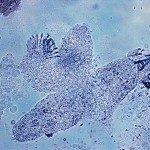About
Nina PAPAVASILIOU – The Rockefeller University (New York – USA)
The African trypanosome (T.brucei spp) is a unicellular parasite native to sub-Saharan Africa, and the causative agent of sleeping sickness in humans and of nagana in livestock. It cycles between a fly vector (the tsetse) and the bloodstream of its mammalian hosts. Within the bloodstream, the parasite is covered by a highly antigenic Variant Surface Glycoprotein (VSG) coat that elicits a robust and specific antibody response, which mediates parasite clearance. Meanwhile, a small proportion of the parasite population switches coats, which stimulates a new antibody response to the prevalent (new) VSG species and this process repeats until immune system failure.
To date, most of the work has focused on mechanisms that initiate VSG switching at the DNA level: once a new VSG is recombined into the active expression site, the assumption is that the new VSG protein will populate the trypanosome surface, and the newly coated trypanosome will therefore be able to evade the antibody response against the old coat. The presentation will focus on VSG protein coat replacement, rather than VSG gene recombination, and will consider questions such as the following: since a trypanosome remains coated with old VSG coat for at least 24h after gene replacement, how does it evade antibody clearance? and more generally, what are the dynamics of the interaction of VSG protein with host antibody? Since at the molecular level, the antibody:VSG interaction surface represents the interface between host and parasite, these issues are central to the pathobiology of T.brucei infection.
Site web du labo : http://mutation.rockefeller.edu
Contact : Philippe BASTIN (philippe.bastin@pasteur.fr – Poste 38.35)

